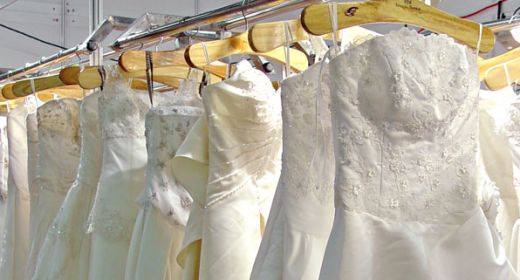Wedding Gown Cleaning Solvents
Author: satoriale
September 18, 2016

- Perchloroethylene:
Commonly called perc. this is the still the most common solvent that dry-cleaners use. It is the best solvent for removing grease and may be your best choice if your dress is silk, rayon, or acetate and quite dirty. However, this solvent is more likely to damage sequins and beads, or melt the glue if they are glued on. A very experienced dry-cleaner will know how to protect the sequins and beads on your dress.
- Stoddard solvent:
Harder to find, this is a petroleum-based solvent that is becoming rare. Because of fire regulations, this solvent cannot be used in strip mall type dry-cleaning establishments, and is therefore not commonly used. You may find this solvent in older dry-cleaning shops that have been around for a while. It is safer for cleaning dresses with sequins and beads than perchloroethylene. The Stoddard solvent shouldn’t melt beads and sequins or affect the glue if they are glued on.
- Exxon DF-2000:
(Also called Hydro-carbon) This is a newly formulated petroleum-based solvent. Like the Stoddard solvent, it is safer for beads and sequins, but is not quite as effective at degreasing as perchloroethylene and the Stoddard solvent. However, it has fewer fire restrictions than the Stoddard formula and may be the formula of the future as many dry-cleaning shops change over to this new solvent.
- Greenearth:
This is a fairly new silicone based solvent. Like Hydro-carbon, it is safer for beads and sequins, but is not quite as effective at removing grease as perchloroethylene and the Stoddard solvent. However, it is safer for the environment and has less government restrictions than any other solvent.

